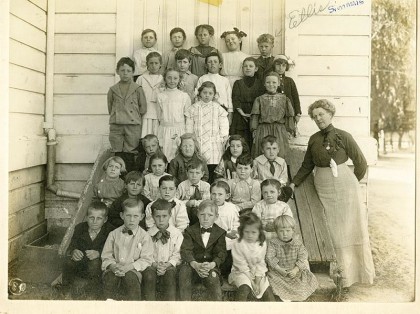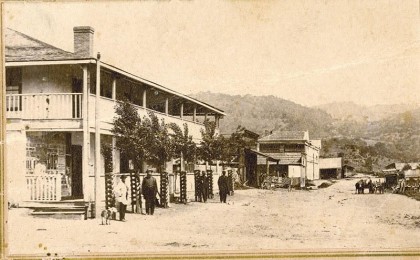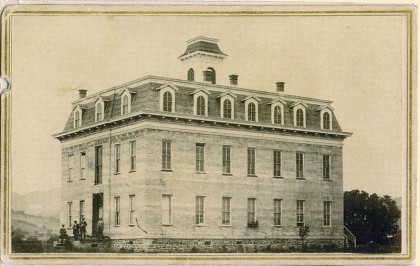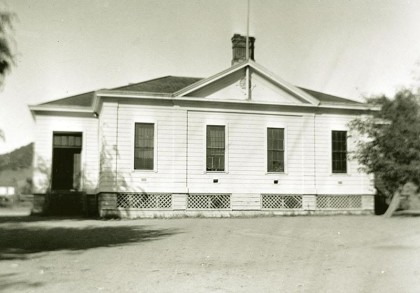Early Education — Sonoma’s First Schools
 (By Linda Blum | Sonoma Valley Sun) — As far back as the time when the memories of Sonoma as a Mexican pueblo, and of the Bear Flag Revolt were still fresh, and when many new settlers were coming from the east, there was an education system — small and informal, but there it was.
(By Linda Blum | Sonoma Valley Sun) — As far back as the time when the memories of Sonoma as a Mexican pueblo, and of the Bear Flag Revolt were still fresh, and when many new settlers were coming from the east, there was an education system — small and informal, but there it was.
It began in 1849, with Gen. Mariano Vallejo’s desire to see his children well schooled. He arranged for a tutor to live with them in his “Casa Grande” facing the muddy pasture that was the Plaza. This was Don Frederika Reger, a Belgian who had lived in Mexico for many years.
 This was followed by St. Mary’s Hall for Young Ladies, started by Dr. J.L. VerMehr of San Francisco, and housed in the Leese-Fitch adobe at the corner of West Spain and First Street West.
This was followed by St. Mary’s Hall for Young Ladies, started by Dr. J.L. VerMehr of San Francisco, and housed in the Leese-Fitch adobe at the corner of West Spain and First Street West.
Vallejo’s daughters were enrolled here, as well as other girls from ‘select families.’ (Dorothea Duhring, of the family that owned the Duhring Building on the Plaza, was a teacher here.) Unfortunately, in 1856, VerMehr closed the school and abandoned Sonoma after losing four of his nine children to diphtheria.
On the other hand, those students who had to attend the first American, non-select school in Sonoma, found themselves in “ a dreary adobe, containing two rows of benches so high that when seated (they) could barely touch the earthen floor with (their) toes.” This was according to Eliza Donner, a young, orphaned survivor of the tragic Donner Party, who had come to live with the Christian Brunner family.
 Still in the private school world, in 1857 a branch of the Cumberland Presbyterian Church of Virginia was opened in the Salvador Vallejo adobe on the west side of the Plaza, in what is now the El Dorado Hotel. It was called The Sonoma Academy, and grew into two buildings and two floors when the Academy became a boarding school and changed its name to Cumberland College.
Still in the private school world, in 1857 a branch of the Cumberland Presbyterian Church of Virginia was opened in the Salvador Vallejo adobe on the west side of the Plaza, in what is now the El Dorado Hotel. It was called The Sonoma Academy, and grew into two buildings and two floors when the Academy became a boarding school and changed its name to Cumberland College.
Cumberland College was the first school in Sonoma to build its own campus, on Broadway at the corner of MacArthur. This three-story cement building, with a mansard roof and bell tower, was finished in 1864, and eventually had an enrollment of as many as 400 students from all over California. In its eight years in operation it was considered “ the finest building in Sonoma.”
But with the opening of the University of California in Berkeley in 1868, many of the students were drained away and the school went into decline.
It remained unused until 1891, when the trustees of the first Sonoma High School voted to lease the premises for $4 a month with an option to buy for $2,500, and a public high school was opened in Sonoma.
The public school system had come to Sonoma in 1857, when the state established a school district for Sonoma and Mendocino Counties. The Sonoma Township, with about 250 children living in the Valley, was divided into four districts: Ash Springs (which later became Oak Grove and was discontinued in 1859), Dunbar, Watmaugh, and Sonoma. These were at first only primary schools, but grew to include students as old as 18.
Before a new public grammar school could be built, the District No.4 students were taught in the Methodist Episcopal Church on Napa Street. The church was later moved to First Street East, where it stands today.
 Finally, in 1868, the newly built Sonoma Grammar School on East Napa Street opened its doors. This was a modern miracle, at a cost of $6,500, with spacious classrooms, large windows, the newest equipment, and lots of room outdoors.
Finally, in 1868, the newly built Sonoma Grammar School on East Napa Street opened its doors. This was a modern miracle, at a cost of $6,500, with spacious classrooms, large windows, the newest equipment, and lots of room outdoors.
We’ll be continuing this story of early Sonoma schools in later editions, and there is a fascinating exhibit in the works at the Depot Museum on First Street West.
Photos courtesy of the Sonoma Historical Society



